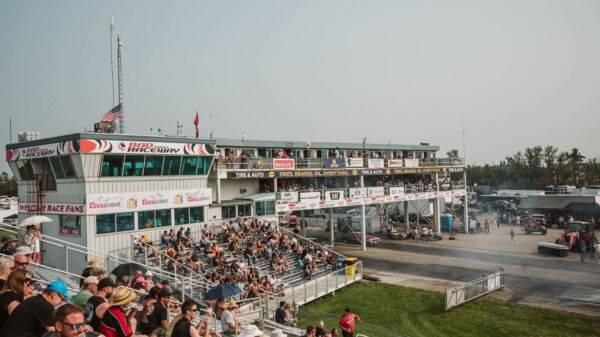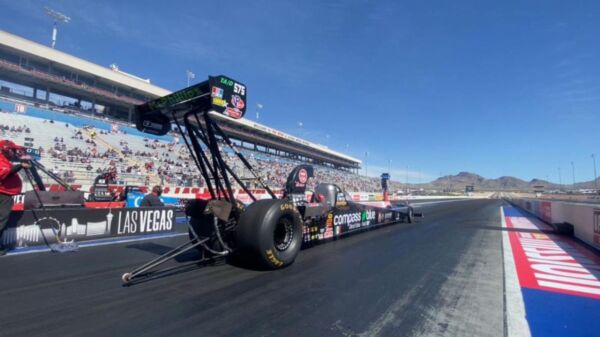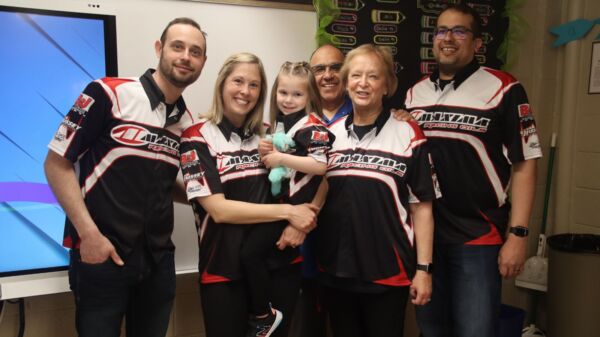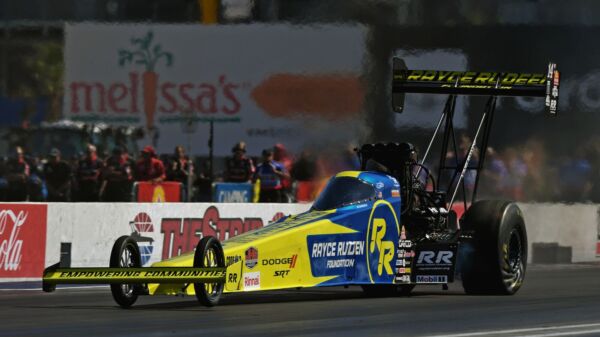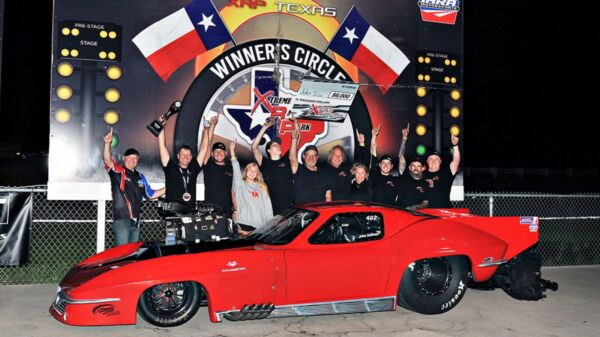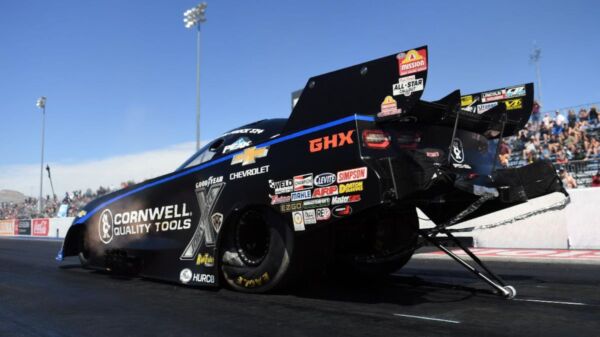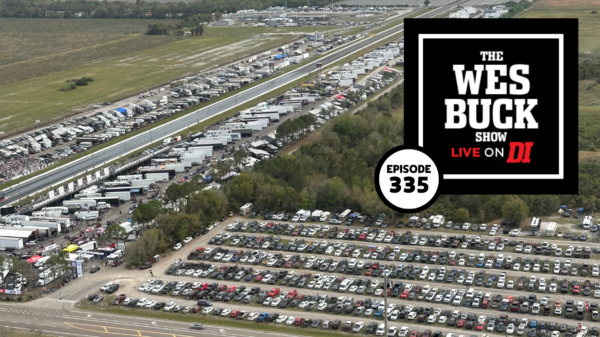Days after a grueling Western Swing in which reigning Top Fuel champion Steve Torrence competed in 11 of a possible 12 elimination rounds, the reverberation of the 11,000 horsepower Capco Contractors Top Fuel dragster echoed through the serene landscape of Ennis, Montana (population 838) with most of the town turning out to witness the dragster make four throttle whacks and celebrate crew chief and Ennis resident Richard Hogan.
Like many of the shenanigans orchestrated by the Capco Contractors team, new wrinkles were piled onto the idea before it became a full-scale event signed off upon by the Torrence family. In this case, an impromptu thought of visiting their leader after the Western Swing and his birthday snowballed into a city-wide gathering. Bobby Lagana Jr. altered the maintenance schedule utilizing the help of the full-time members of the part-time second car driven by Billy Torrence so they could stay on the road for a day in Ennis and head straight to Brainerd without having to visit their Indianapolis shop.
“It’s great to see how much he means to the people where he lives,” says Lagana. “We have a lot of fun. I think the fun is part of our success.”
Hogan, a Florida native who relocated to Ennis while he was working on the late John Mitchell’s Montana Express dragster in the mid-1990s, is enjoying the best run of his career during a string of success with Torrence that included 11 wins and a 6-0 sweep of the Countdown to the Championship playoff events in 2018. Through 16 races in 2019, Torrence has won eight races in 11 finals with father Billy claiming two of the other victories.
With megateams such as John Force Racing, Don Schumacher Racing, and Kalitta Motorsports filling the fields with cars and manufacturing many of their own parts, the success of the Capco Contractors team bucks the trend with store-bought parts and only one car on a full schedule. Hogan and Lagana provide insight into how they are able to stand atop the Kings of the Sport in the modern era.
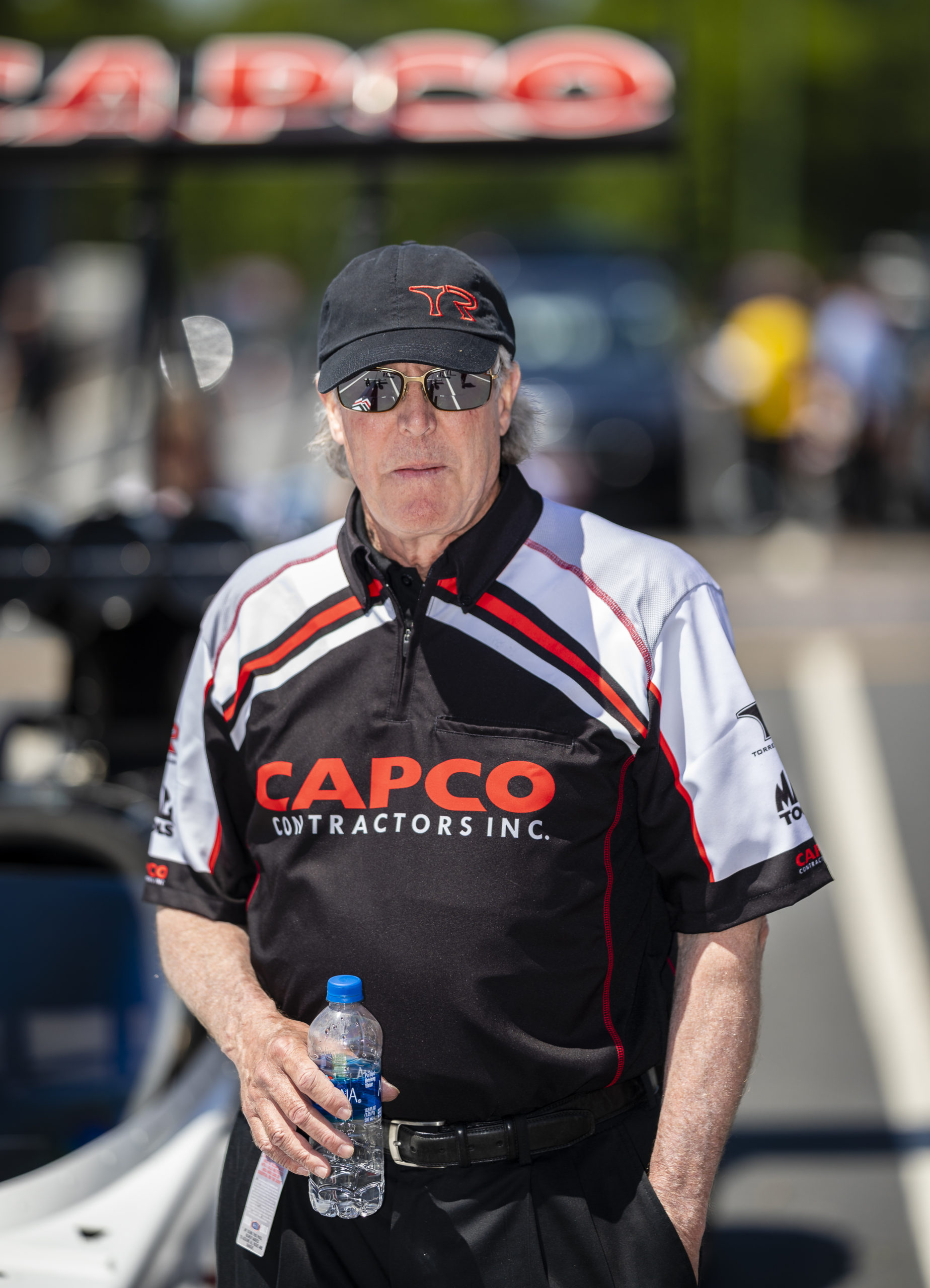
Photo by Rick Belden
PEOPLE AND PLANNING
The first thing Hogan mentions when asked what is behind the success of the Capco Contractors dragster is his crew.
“The biggest thing is having the same crew guys for so long now,” says Hogan. “That, anymore, is huge to have the maintenance at the level we keep it at, especially when we are going so many rounds. Having Billy’s guys at the shop to help work on our stuff when we get back has helped keep everything up to 100 percent. That is almost impossible for some teams, some of it because of funding and some of it because of personnel. How many teams have 10-12 guys to work on a car when they get back to the shop if they have to?”
“Honestly, the biggest thing is how close-knit we are,” Lagana adds. “Some of the guys on the team have been racing together and close friends for almost 20 years. Some of us have worked with ‘Hogie’ before. Being able to work with him here, he’s so old school and cares about the right things. There is a lot of respect, honesty and trust. Everybody has to believe every little thing on the car — the servicing, the traveling, work dates at the shop, time off. There is so much that goes into keeping everybody happy, and when they are happy they do their best work on the car. Steve believes in the team and believes in the car. It’s hard to beat that.”
In addition to the continuity of the Capco Contractors roster, the number of those with crew chief experience is impressive. Hogan and Lagana are joined by Justin Crosslin, who had previously worked his way from the bottom to a co-crew chief position for Clay Millican’s former team. The other dragster features Jason McCulloch on the full-time crew; Walt Przybyl, who relishes the opportunity to assist a competitive team on a part-time schedule that works around his engineering business in upstate New York; and part-time Top Fuel racer Dom Lagana.
“I always say we have three crew chiefs on our car and two on Billy’s with ‘Jake’ [McCulloch] and Wally, three if you throw Dom in the mix,” says Hogan. “Justin is crew chief quality, and then you have Bobby and me. That’s pretty good to have three for each car. We took Justin out of the loop on cylinder head maintenance so he can help with everything else to make sure everything is really what we want it to be every time we go to the starting line and oversee all the maintenance. I’m getting him to make more calls on blower overdrive and stuff. Sometimes now, he just knows what we’re going to do and he doesn’t even have to ask me.”
PARTS
When the Capco Contractors dragster pulls up to the starting line, the components are either in new or like-new condition. This requires a great deal of planning and an ample budget, but it takes big variables away from the tuners.
“The biggest part is being able to know the thing is the same all the time,” says Hogan. “We are cycling parts constantly and selling them when they need to be sold. We figured out a long time ago that there is a lot to that. You get to making runs and swapping blowers and heads and shortblocks. Sometimes the parts want to do right and sometimes they don’t. We found a lot of that has to do with stuff not being as nice you think it is – exhaust feeds being down further than they need to be, etc. A lot of teams just can’t cycle their stuff the way we do to keep it basically brand new every time it goes to the starting line.
“We don’t even put guides or seats in our cylinder heads. We sell them before that point. Most teams can’t do that. Unless you set your program up to do it that way, you think you can’t afford it. We’ve done it from the start, and it has really paid off, especially with the cylinder heads. The blower cases are perfect. Some teams will get a backfire and they’ll be tweaked a little bit. We sell them before it gets to that point. There are guys in line to buy them, and they’re still good but not perfect. It really seems to make a difference.”
Planning is paramount when it comes to receiving parts from vendors and cycling parts out to other teams in the NHRA Mello Yello Drag Racing Series and abroad.
“It takes a lot just to plan on having the parts coming from AJPE, Sonny Bryant, Jesel, RCD, Aerodine, and all of them,” says Hogan. “You have to plan way in advance to keep your stuff stockpiled. You have one ‘oops,’ and you lose everything. We’ve had injector-to-oil-pans on either car for whatever reason, and we’ve been able to recover without being short on parts at all. It’s quite the undertaking, but they’ve been able to keep up with it. I only occasionally hear from Billy if the stack of invoices that goes to the office at one time is a little too thick.”
One advantage to only having one full-time team is the ability to control the clutch disc inventory.
“Our clutch program is so good, because our inventory gradually gets bigger and bigger with one full-time car,” says Hogan. “The stuff we have now will be run in 2020, and Billy will start running from one or two batches that we haven’t gotten into yet so we’ll be set for next year. It’s not always me making the calls with how we run the clutch program — that’s Bobby and Gary [Pritchett] and they tell me what position the clutch discs are in, and we go from there.”
CULTURE
The phrase “speed brings harmony” is but one reason why the Capco Contractors team is able to keep the same people on the road and in the shop in a grueling profession that often sees a lot of turnover. The Torrence family of Billy, Kay and Steve have surrounded themselves with a tight-knit group and provided an environment where they can be themselves within the structured world of Top Fuel racing.
“I don’t [mess] with them — that helps,” Hogan jokes. “They are all well-rounded. We try to let them do their stuff that they want to do and be flexible about giving time off if they have their stuff done. We try to keep everybody happy. Families come to the races when they can. There is a good environment. The shop is nice, and we have nice equipment. Guys who like that kind of surrounding and environment don’t want to go somewhere else. They don’t want to go to a multicar team and have to go to a multicar team and have to deal with all the politics and everything. When we run Billy’s car, everybody wants to outrun each other, but afterwards it’s all good again.”
“There is no pride or ego on this team,” Lagana adds. “‘Hogie’ is our crew chief and our leader, but we don’t talk titles. There is no disconnect from person to person. It’s an awesome place to be. We have a good time whether we win or lose, which I think is really important. You have to be willing to accept that everything isn’t going to go perfect. Through our whole lives, our mantra was that our success was going to be determined by how you handle your next failure. I think that is what makes you a stronger team.”
Lagana endearingly uses the term “old school” to describe Hogan.
“He is a bearings-and-rings guy,” says Lagana. “Every run, he looks at the bearings and rings. Any kind of input that Steve or any guy on the team has, he wants. That’s how everybody raced old school before we got as intricate of a data recorder as we have now. Same goes with the track. Looking at how you decide how good you think the track is, he still goes by temperature and how good it feels on your foot. There is a lot of intuition. Our tune-up program isn’t just typing in the weather for the blower overdrive and gasket. There is a lot of seat-of-your-pants and instinct from ‘Hogie.’ We also have five good years of making good runs with the same combination and same crew guys, and that data is invaluable. That’s old school, too — taking notes on everything.”
“It’s just the way I was brought up,” says Hogan. “There were no computers, I drove the truck, and I know how it is when you blow stuff up and don’t learn anything. I had always learned from way back how important it is to run good without wearing it out. Sometimes you have to bite the bullet and not be low e.t. to see if you can get away with it or not. To not tear anything up if you don’t have to is a big deal. You can get lost so fast if you start hurting it every run. Obviously, Bobby and those guys have always been on a tight budget with their own equipment so they learned how important it is to not tear [stuff] up. It’s easy to get in a mindset and say, ‘I’ve got a trailer full of parts.’ And then you run out.”
Hogan’s approach was shaped by his experience working with other notable tuners.
“I was with [Dale] Armstrong doing bottom end on [Kenny] Bernstein’s car,” Hogan recalls. “It was brutal. We’d go out there and make runs to 300 feet and be blown up, test the next day and be blown up. There was just carnage everywhere. We know better, but we’re just following the chief. Then he’d get it right and we’d be OK. Holy smokes, it was tough to keep up with. We’d be in the pits putting racks together while the guys were running the car so we could keep up with the next round. So I’ve been on the other side of it.
“Dale was a great guy to work for with his personality and how he treated us. I learned a lot from him. [Wes] Cerny was the same way, kind of going along with everything as long as the work got done. He was real picky on the tuning calls and stuff. He was one of the first guys I’d been around that was real picky on stuff like that. Then there was Garlits, who did everything from building the cars to running, driving and getting it ready. How do you match that? Plus there was the environment of being around him when he was hard to deal with. He has mellowed out a bunch, but it wasn’t easy. It kind of helps me remind myself when I get a little cranky not to bark at the crew guys and keep my mouth shut — ‘I’ve been through this myself; that’s not going to help. Don’t go that route.’ I think the crew guys appreciate that. If you bark at them sometimes, it means something. If you do that all the time, they get numb to it.”
Both Hogan and Lagana credit Steve’s ability in the car and good fortune along with the reasons for their success so far. Through it all, Hogan remains the same person – friendly and humble, enjoying the moment without relishing the spotlight.
“I don’t have any interest in that,” says Hogan. “I just want e.t. slips and bonus checks. There has been a good run of that, so I won’t complain.”

